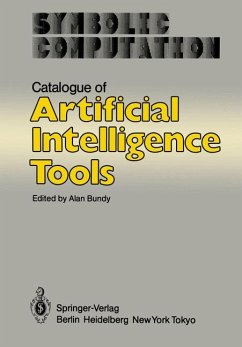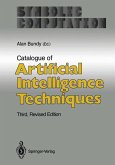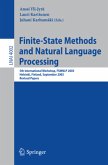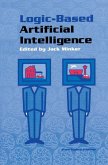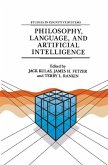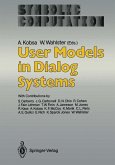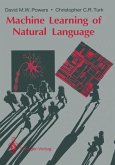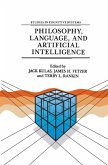Catalogue of Artificial Intelligence Tools
Mitarbeit: Wallen, Lincoln; Herausgegeben von Bundy, A.
Catalogue of Artificial Intelligence Tools
Mitarbeit: Wallen, Lincoln; Herausgegeben von Bundy, A.
- Broschiertes Buch
- Merkliste
- Auf die Merkliste
- Bewerten Bewerten
- Teilen
- Produkt teilen
- Produkterinnerung
- Produkterinnerung
The purpose of this catalogue is to promote interaction between members of the AI' community. It will do this by announcing the existence of Ai techniques and portable software. and acting as a pOinter into the literature. Thus the AI community wili have access to a common. extensional definition of the field. which will: promote a common terminology. discourage the reinvention of wheels. and act as a clearing house for ideas and software. The cataiogue is a reference work providing a quick guide to the AI tools available for different jobs. It is not intended to be a textbook like the…mehr
Andere Kunden interessierten sich auch für
![Catalogue of Artificial Intelligence Techniques Catalogue of Artificial Intelligence Techniques]() Catalogue of Artificial Intelligence Techniques77,99 €
Catalogue of Artificial Intelligence Techniques77,99 €![Finite-State Methods and Natural Language Processing Finite-State Methods and Natural Language Processing]() Anssi Yli-Jyrä (Volume ed.) / Lauri Karttunen / Juhani KarhumäkiFinite-State Methods and Natural Language Processing39,99 €
Anssi Yli-Jyrä (Volume ed.) / Lauri Karttunen / Juhani KarhumäkiFinite-State Methods and Natural Language Processing39,99 €![Logic-Based Artificial Intelligence Logic-Based Artificial Intelligence]() Logic-Based Artificial Intelligence164,99 €
Logic-Based Artificial Intelligence164,99 €![Philosophy, Language, and Artificial Intelligence Philosophy, Language, and Artificial Intelligence]() J. Kulas / J.H. Fetzer / T.L. Rankin (Hgg.)Philosophy, Language, and Artificial Intelligence229,99 €
J. Kulas / J.H. Fetzer / T.L. Rankin (Hgg.)Philosophy, Language, and Artificial Intelligence229,99 €![User Models in Dialog Systems User Models in Dialog Systems]() User Models in Dialog Systems77,99 €
User Models in Dialog Systems77,99 €![Machine Learning of Natural Language Machine Learning of Natural Language]() David M. W. PowersMachine Learning of Natural Language39,99 €
David M. W. PowersMachine Learning of Natural Language39,99 €![Philosophy, Language, and Artificial Intelligence Philosophy, Language, and Artificial Intelligence]() Philosophy, Language, and Artificial Intelligence153,99 €
Philosophy, Language, and Artificial Intelligence153,99 €-
-
-
The purpose of this catalogue is to promote interaction between members of the AI' community. It will do this by announcing the existence of Ai techniques and portable software. and acting as a pOinter into the literature. Thus the AI community wili have access to a common. extensional definition of the field. which will: promote a common terminology. discourage the reinvention of wheels. and act as a clearing house for ideas and software. The cataiogue is a reference work providing a quick guide to the AI tools available for different jobs. It is not intended to be a textbook like the Artificial Intelligence Handbook. It. intentionally. only provides a brief description of each tool. with no extended discussion of the historical origin of the tool or how it has been used in particular AI programs, The focus is on techniques abstracted from their historical origins. The original version of the catalogue. was hastily built in 1983 as part of the UK SERC-Dol. IKBS. Architecture Study [lKBS Architecture Study 831. it has now been adopted by the SERC Specially Promoted Programme in IKBS and is kept as an on line document undergoing constant revision and refinement and published as a paperback by Springer Verlag.
Hinweis: Dieser Artikel kann nur an eine deutsche Lieferadresse ausgeliefert werden.
Hinweis: Dieser Artikel kann nur an eine deutsche Lieferadresse ausgeliefert werden.
Produktdetails
- Produktdetails
- Symbolic Computation
- Verlag: Springer / Springer Berlin Heidelberg / Springer, Berlin
- Artikelnr. des Verlages: 978-3-540-13938-6
- 1984.
- Seitenzahl: 180
- Erscheinungstermin: 1. November 1984
- Englisch
- Abmessung: 244mm x 170mm x 11mm
- Gewicht: 321g
- ISBN-13: 9783540139386
- ISBN-10: 3540139389
- Artikelnr.: 25262368
- Herstellerkennzeichnung
- Springer-Verlag GmbH
- Tiergartenstr. 17
- 69121 Heidelberg
- ProductSafety@springernature.com
- Symbolic Computation
- Verlag: Springer / Springer Berlin Heidelberg / Springer, Berlin
- Artikelnr. des Verlages: 978-3-540-13938-6
- 1984.
- Seitenzahl: 180
- Erscheinungstermin: 1. November 1984
- Englisch
- Abmessung: 244mm x 170mm x 11mm
- Gewicht: 321g
- ISBN-13: 9783540139386
- ISBN-10: 3540139389
- Artikelnr.: 25262368
- Herstellerkennzeichnung
- Springer-Verlag GmbH
- Tiergartenstr. 17
- 69121 Heidelberg
- ProductSafety@springernature.com
1. 2 1/2-D Sketch.- 2. A* Algorithm.- 3. ACLS: Analogue Concept Learning System.- 4. Actors.- 5. AGE.- 6. ALICE.- 7. Alpha/Beta Pruning.- 8. AL/X.- 9. AMORD.- 10. Analogical Problem Solving.- 11. APES.- 12. ARBY.- 13. Associative Database.- 14. Augmented Transition Network.- 15. B* Algorithm.- 16. Bandpass Filter.- 17. Bayesian Inference.- 18. Bidirectional Search.- 19. Blackboard.- 20. Bottom-Up Parsing.- 21. Boundary Detection.- 22. Boyer-Moore Theorem Prover.- 23. Branch-and-Bound Algorithms.- 24. Breadth-First Parsing.- 25. Breadth-First Search.- 26. Cambridge LISP.- 27. Cascaded Augmented Transition Network.- 28. Case Frames.- 29. Cellular Arrays.- 30. Chart Parsing.- 31. CHI.- 32. Classification.- 33. Clausal Form.- 34. Common LISP.- 35. Computer Audiometry.- 36. Conceptual Dependency.- 37. Connection Machine.- 38. CONNIVER.- 39. Constraint Satisfaction and Propagation.- 40. Constructive Solid Geometry.- 41. Context-Free Grammar.- 42. Contour Generator.- 43. Contradiction Backtracing.- 44. Contrast Sensitivity Function.- 45. Convolution.- 46. DADO.- 47. Data-Directed Control.- 48. Default Reasoning.- 49. Definite Clause Grammars.- 50. Delayed Evaluation.- 51. Demon.- 52. Dempster-Shafer Theory.- 53. Dependency Directed Backtracking.- 54. Depth-First Parsing.- 55. Depth-First Search.- 56. Deterministic Parsing.- 57. Difference of Gaussians.- 58. Discrimination Learning.- 59. Discrimination Net.- 60. Distance Transform.- 61. Distributed Problem Solving.- 62. Dynamic Programming.- 63. Dynamic Time Warping.- 64. Earleys Algorithm.- 65. Edge Detection.- 66. EMYCIN.- 67. Envisioning.- 68. Expert.- 69. Fast Pattern Recognition Techniques.- 70. Finding Common Paths.- 71. Flynn Classification.- 72. Focussing.- 73. Formant.- 74. Formant Synthesis.- 75. FORTRAN.- 76. Forward/Bacward Search.- 77. Frame.- 78. FRL.- 79. Functional Data Model.- 80. Functional Grammar.- 81. Fuzzy Relational Products.- 82. Fuzzy Set Theory.- 83. Generalised Cylinders.- 84. Generalised Hough Transform.- 85. Generative Capacity.- 86. Goal Structure.- 87. Golay Neighbourhoods.- 88. Gradient Space.- 89. Grey-Level Image.- 90. Heterarchy.- 91. Hearsay-III.- 92. Heuristic Search.- 93. Hierarchical Planning.- 94. High-Emphasis Filtering.- 95. Hook.- 96. Hope.- 97. Horn Clauses.- 98. Image Data Structures.- 99. Image Segmentation.- 100. Inference Engine Toolkit.- 101. Inferno.- 102. Interactions Between Sub-Goals.- 103. Interlisp-D.- 104. Intern Demons.- 105. Intrinsic Images.- 106. Invariant Queues.- 107. Invariant Violation Demons.- 108. ISA Hierarchy.- 109. Island Parsing.- 110. Junction Dictionary.- 111. KAS: Knowleoge Acquisition System.- 112. Kinematics.- 113. KL-ONE/KL-TWO.- 114. KRC.- 115. KRL.- 116. Laplacian.- 117. LCF.- 118. Learning from Solution Paths.- 119. Lexical Access.- 120. LIFER.- 121. Line Finding.- 122. Line Labelling.- 123. Linear Predictive Coding.- 124. Lispkit.- 125. LM.- 126. LM-GEO.- 127. Local Grey-Level Operations.- 128. Logic Machine Architecture.- 129. LOGLISP.- 130. LOGO.- 131. LOOPS.- 132. MACLISP.- 133. Macro Operators.- 134. MACSYMA.- 135. Markgraf Karl Refutation Procedure.- 136. MBASE.- 137. MDL.- 138. Means/Ends Analysis.- 139. Meta-Level Inference.- 140. Meta-Planning.- 141. Meta-Rules.- 142. Micro Expert.- 143. Micro-PLANNER.- 144. Micro-PROLOG.- 145. Minimax.- 146. ML.- 147. Model Directed Search.- 148. Modulation Transfer Function.- 149. Morphographemics.- 150. MProlog.- 151. Multi-Actor System.- 152. Multi-Pulse LPC.- 153. Natural Deduction.- 154. Negation as Failure.- 155. Neighbourhood Parallelism.- 156. NIAL (Nested Interactive Array Language).- 157. NIL.- 158. Non-Linear Planning.- 159. Non-Monotonic Reasoning.- 160. Numerically-Controlled Machine Tools.- 161. Object-Centred Co-Ordinates.- 162. One-Then-Best Backtracking.- 163. Operator Table.- 164. Operators.- 165. Opportunistic Search.- 166. OPS5.- 167. Optical Flow.- 168. Optimistic Plan Execution.- 169. Overloaded Operators.- 170. Paramodulation.- 171. Partial Evaluation.- 172. Partitioned Semantic Net.- 173. Pattern Directed Retrieval/Invocation.- 174. Pattern Matching.- 175. Perceptrons.- 176. Photometric Stereo.- 177. Pipelining.- 178. Pitch Extraction.- 179. Plan Recognition.- 180. Plan Structure.- 181. POP-2.- 182. POP-11.- 183. POPLOG.- 184. Portable Standard LISP.- 185. Postulating Intrinsic Properties.- 186. Precondition Analysis.- 187. Predictive Parsing.- 188. Procedural Attachment.- 189. Predicate Calculus.- 190. Preference Semantics.- 191. Primal Sketch.- 192. Production Rule System.- 193. Program Synthesis.- 194. Program Transformation.- 195. Programming Cliche.- 196. PROLOG.- 197. Propagation in Cellular Arrays.- 198. Property Lists.- 199. Propositional Constraint Propagation.- 200. Protocol Analysis.- 201. PSI.- 202. Pyramids/Resolution Cones.- 203. QLISP/QA4.- 204. Quad Trees.- 205. RAPT.- 206. Reflectance Map.- 207. Refutation Proof.- 208. Region Finding.- 209. Relational Database Query Formulation.- 210. Relaxation Labelling.- 211. Remote Procedure Calls.- 212. Resolution.- 213. Rewrite Rules.- 214. RLL.- 215. ROBMOD.- 216. Robot Dynamics.- 217. Robot Programming.- 218. ROSIE.- 219. RUP.- 220. SAGE.- 221. SAIL.- 222. SASL.- 223. SCRIPT.- 224. Semantic Binary Relationship Model.- 225. Semantic Checking.- 226. Semantic Grammar.- 227. Semantic Net.- 228. Semantic Primitives.- 229. Sensory Feedback and Compliance.- 230.Shape Analysis.- 231. Shape From Shading.- 232. Shape from Texture.- 233. Situation Calculus.- 234. Skeletonisation.- 235. Skolemization.- 236. SmallTalk.- 237. Spatial Differentiation.- 238. Spatial Frequency Channels.- 239. Spelling Correction.- 240. State Space.- 241. Stereopsis.- 242. Structured Induction.- 243. Subgoaling.- 244. SYNICS.- 245. Table of Multiple Effects.- 246. Template Matching.- 247. Time Complexity of Recognition.- 248. Top-Down Parsing.- 249. T-PROLOG.- 250. Truth Maintenance System.- 251. Typed Preconditions.- 252. Unification.- 253. Units.- 254. The UT Theorem Prover.- 255. Variable-Valued Logic.- 256. Version Space.- 257. Viewer-centred Co-ordinates.- 258. Vocoder Representation.- 259. VOLE.- 260. Vowel Quadrilateral.- 261. Zero-Crossings.- 262. ZETALISP.- 263. ZMOB.- 264. ZOG.- Index of Definitions.
1. 2 1/2-D Sketch.- 2. A* Algorithm.- 3. ACLS: Analogue Concept Learning System.- 4. Actors.- 5. AGE.- 6. ALICE.- 7. Alpha/Beta Pruning.- 8. AL/X.- 9. AMORD.- 10. Analogical Problem Solving.- 11. APES.- 12. ARBY.- 13. Associative Database.- 14. Augmented Transition Network.- 15. B* Algorithm.- 16. Bandpass Filter.- 17. Bayesian Inference.- 18. Bidirectional Search.- 19. Blackboard.- 20. Bottom-Up Parsing.- 21. Boundary Detection.- 22. Boyer-Moore Theorem Prover.- 23. Branch-and-Bound Algorithms.- 24. Breadth-First Parsing.- 25. Breadth-First Search.- 26. Cambridge LISP.- 27. Cascaded Augmented Transition Network.- 28. Case Frames.- 29. Cellular Arrays.- 30. Chart Parsing.- 31. CHI.- 32. Classification.- 33. Clausal Form.- 34. Common LISP.- 35. Computer Audiometry.- 36. Conceptual Dependency.- 37. Connection Machine.- 38. CONNIVER.- 39. Constraint Satisfaction and Propagation.- 40. Constructive Solid Geometry.- 41. Context-Free Grammar.- 42. Contour Generator.- 43. Contradiction Backtracing.- 44. Contrast Sensitivity Function.- 45. Convolution.- 46. DADO.- 47. Data-Directed Control.- 48. Default Reasoning.- 49. Definite Clause Grammars.- 50. Delayed Evaluation.- 51. Demon.- 52. Dempster-Shafer Theory.- 53. Dependency Directed Backtracking.- 54. Depth-First Parsing.- 55. Depth-First Search.- 56. Deterministic Parsing.- 57. Difference of Gaussians.- 58. Discrimination Learning.- 59. Discrimination Net.- 60. Distance Transform.- 61. Distributed Problem Solving.- 62. Dynamic Programming.- 63. Dynamic Time Warping.- 64. Earleys Algorithm.- 65. Edge Detection.- 66. EMYCIN.- 67. Envisioning.- 68. Expert.- 69. Fast Pattern Recognition Techniques.- 70. Finding Common Paths.- 71. Flynn Classification.- 72. Focussing.- 73. Formant.- 74. Formant Synthesis.- 75. FORTRAN.- 76. Forward/Bacward Search.- 77. Frame.- 78. FRL.- 79. Functional Data Model.- 80. Functional Grammar.- 81. Fuzzy Relational Products.- 82. Fuzzy Set Theory.- 83. Generalised Cylinders.- 84. Generalised Hough Transform.- 85. Generative Capacity.- 86. Goal Structure.- 87. Golay Neighbourhoods.- 88. Gradient Space.- 89. Grey-Level Image.- 90. Heterarchy.- 91. Hearsay-III.- 92. Heuristic Search.- 93. Hierarchical Planning.- 94. High-Emphasis Filtering.- 95. Hook.- 96. Hope.- 97. Horn Clauses.- 98. Image Data Structures.- 99. Image Segmentation.- 100. Inference Engine Toolkit.- 101. Inferno.- 102. Interactions Between Sub-Goals.- 103. Interlisp-D.- 104. Intern Demons.- 105. Intrinsic Images.- 106. Invariant Queues.- 107. Invariant Violation Demons.- 108. ISA Hierarchy.- 109. Island Parsing.- 110. Junction Dictionary.- 111. KAS: Knowleoge Acquisition System.- 112. Kinematics.- 113. KL-ONE/KL-TWO.- 114. KRC.- 115. KRL.- 116. Laplacian.- 117. LCF.- 118. Learning from Solution Paths.- 119. Lexical Access.- 120. LIFER.- 121. Line Finding.- 122. Line Labelling.- 123. Linear Predictive Coding.- 124. Lispkit.- 125. LM.- 126. LM-GEO.- 127. Local Grey-Level Operations.- 128. Logic Machine Architecture.- 129. LOGLISP.- 130. LOGO.- 131. LOOPS.- 132. MACLISP.- 133. Macro Operators.- 134. MACSYMA.- 135. Markgraf Karl Refutation Procedure.- 136. MBASE.- 137. MDL.- 138. Means/Ends Analysis.- 139. Meta-Level Inference.- 140. Meta-Planning.- 141. Meta-Rules.- 142. Micro Expert.- 143. Micro-PLANNER.- 144. Micro-PROLOG.- 145. Minimax.- 146. ML.- 147. Model Directed Search.- 148. Modulation Transfer Function.- 149. Morphographemics.- 150. MProlog.- 151. Multi-Actor System.- 152. Multi-Pulse LPC.- 153. Natural Deduction.- 154. Negation as Failure.- 155. Neighbourhood Parallelism.- 156. NIAL (Nested Interactive Array Language).- 157. NIL.- 158. Non-Linear Planning.- 159. Non-Monotonic Reasoning.- 160. Numerically-Controlled Machine Tools.- 161. Object-Centred Co-Ordinates.- 162. One-Then-Best Backtracking.- 163. Operator Table.- 164. Operators.- 165. Opportunistic Search.- 166. OPS5.- 167. Optical Flow.- 168. Optimistic Plan Execution.- 169. Overloaded Operators.- 170. Paramodulation.- 171. Partial Evaluation.- 172. Partitioned Semantic Net.- 173. Pattern Directed Retrieval/Invocation.- 174. Pattern Matching.- 175. Perceptrons.- 176. Photometric Stereo.- 177. Pipelining.- 178. Pitch Extraction.- 179. Plan Recognition.- 180. Plan Structure.- 181. POP-2.- 182. POP-11.- 183. POPLOG.- 184. Portable Standard LISP.- 185. Postulating Intrinsic Properties.- 186. Precondition Analysis.- 187. Predictive Parsing.- 188. Procedural Attachment.- 189. Predicate Calculus.- 190. Preference Semantics.- 191. Primal Sketch.- 192. Production Rule System.- 193. Program Synthesis.- 194. Program Transformation.- 195. Programming Cliche.- 196. PROLOG.- 197. Propagation in Cellular Arrays.- 198. Property Lists.- 199. Propositional Constraint Propagation.- 200. Protocol Analysis.- 201. PSI.- 202. Pyramids/Resolution Cones.- 203. QLISP/QA4.- 204. Quad Trees.- 205. RAPT.- 206. Reflectance Map.- 207. Refutation Proof.- 208. Region Finding.- 209. Relational Database Query Formulation.- 210. Relaxation Labelling.- 211. Remote Procedure Calls.- 212. Resolution.- 213. Rewrite Rules.- 214. RLL.- 215. ROBMOD.- 216. Robot Dynamics.- 217. Robot Programming.- 218. ROSIE.- 219. RUP.- 220. SAGE.- 221. SAIL.- 222. SASL.- 223. SCRIPT.- 224. Semantic Binary Relationship Model.- 225. Semantic Checking.- 226. Semantic Grammar.- 227. Semantic Net.- 228. Semantic Primitives.- 229. Sensory Feedback and Compliance.- 230.Shape Analysis.- 231. Shape From Shading.- 232. Shape from Texture.- 233. Situation Calculus.- 234. Skeletonisation.- 235. Skolemization.- 236. SmallTalk.- 237. Spatial Differentiation.- 238. Spatial Frequency Channels.- 239. Spelling Correction.- 240. State Space.- 241. Stereopsis.- 242. Structured Induction.- 243. Subgoaling.- 244. SYNICS.- 245. Table of Multiple Effects.- 246. Template Matching.- 247. Time Complexity of Recognition.- 248. Top-Down Parsing.- 249. T-PROLOG.- 250. Truth Maintenance System.- 251. Typed Preconditions.- 252. Unification.- 253. Units.- 254. The UT Theorem Prover.- 255. Variable-Valued Logic.- 256. Version Space.- 257. Viewer-centred Co-ordinates.- 258. Vocoder Representation.- 259. VOLE.- 260. Vowel Quadrilateral.- 261. Zero-Crossings.- 262. ZETALISP.- 263. ZMOB.- 264. ZOG.- Index of Definitions.

